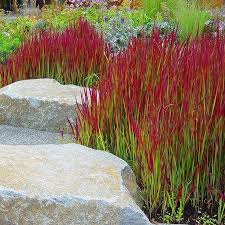Japanese Blood Grass: Stunning Red-Tipped Foliage
Discover the beauty of Japanese Blood Grass (Imperata cylindrica), known for its striking red-tipped foliage. This perennial grass typically grows 24 to 36 inches tall and spreads 18 to 24 inches wide under optimal conditions, making it a perfect addition to your garden.
6/2/20254 min read


Height and Spread of Japanese Blood Grass
Japanese Blood Grass (Imperata cylindrica), renowned for its visually captivating red-tipped foliage, generally exhibits a moderate growth pattern. Under optimal conditions, this perennial grass reaches heights ranging from 24 to 36 inches and spreads about 18 to 24 inches wide. These dimensions can vary based on several environmental factors and the care practices implemented by the gardener.
When planted in well-drained soil enriched with organic matter, Japanese Blood Grass flourishes, maximizing its height and spread potential. The grass tends to thrive in full sun to partial shade, with full sunlight being particularly beneficial for enhancing its vibrant coloration. However, in more shaded regions, it may not reach its maximum height and can become thinner in appearance. Poor drainage and overly shaded environments can lead to stunted growth and a reduced spread.
Watering practices also play a crucial role in determining the size of Japanese Blood Grass. Consistent watering during the growing season encourages robust growth, while drought conditions can stunt its development. Once established, the grass exhibits a moderate tolerance for drought, but prolonged dry spells can lead to diminished health and vigor, affecting its overall size.
Fertilization can further influence the growth patterns of this striking grass. Applying a balanced fertilizer in the early spring can promote lush growth, helping to achieve the height and spread characteristic of healthy Japanese Blood Grass. Additionally, proper spacing during planting can prevent overcrowding, allowing each plant to expand adequately and reach its full potential. With attention to these various factors, gardeners can cultivate a vibrantly colorful display of Japanese Blood Grass in their landscapes.
Availability and Purchase Options for Japanese Blood Grass
Japanese Blood Grass, scientifically known as Imperata cylindrica 'Red Baron,' has gained popularity among gardeners for its vibrant red tips and arching foliage. This attractive ornamental grass can be found at a variety of retail outlets, making it relatively accessible for prospective buyers. When looking to purchase Japanese Blood Grass, individuals can consider several options, including local nurseries, garden centers, and online retailers.
Local nurseries often have a seasonal variety of plants, including Japanese Blood Grass. Buying directly from a nursery allows customers to inspect the health of the plants and benefit from the locale's microclimate advice from the staff. Many centers stock seasonal selections, so it is a good practice to visit during spring or early summer when Japanese Blood Grass is typically available in abundance. Prices at local outlets generally range from $10 to $30 per plant, depending on size and variety.
Alternatively, numerous online retailers specialize in ornamental grasses, making purchasing Japanese Blood Grass from the comfort of home a viable option. Websites such as Plant Delights Nursery or High Country Gardens may offer an extensive selection year-round. Shopping online may also provide opportunities to find unique varieties or larger quantities. However, customers should factor in shipping costs and potential delays, as these can influence the overall purchase experience.
When selecting Japanese Blood Grass, it is essential to choose healthy specimens characterized by vibrant color and robust growth. Buyers should look for plants free of pests or any signs of disease. Additionally, checking the root system for signs of a healthy plant can increase the likelihood of successful establishment in the garden. As this ornamental grass can enhance any landscape design, selecting the right source is critical for maximizing its aesthetic potential.
Assessing the Invasiveness of Japanese Blood Grass
Japanese Blood Grass, scientifically known as Imperata cylindrica, is a species that has garnered attention due to its ornamental features and growth habits. While many gardeners appreciate its vibrant red tips and ability to thrive in various soil types, it is crucial to assess its potential invasiveness in certain regions. This plant exhibits traits that can contribute to aggressive spreading, particularly in temperate climates where it is non-native. Its rhizomatic root system allows it to expand quickly, often encroaching on neighboring plants and altering local ecosystems.
The characteristics that make Japanese Blood Grass attractive for landscaping also pose challenges for garden management. Once established, it can outcompete native flora for resources, thereby diminishing biodiversity. This behavior raises concerns among horticulturists, land managers, and environmentalists alike, prompting a closer examination of local regulations concerning its cultivation. In many states, there are restrictions or recommendations against planting species that are deemed invasive, and caution is advised to avoid unintended consequences to native habitats.
To mitigate the risks associated with Japanese Blood Grass, gardeners must implement effective control measures. This could include regular monitoring of plant spread, establishing physical barriers to limit its rhizome growth, and promptly removing any unwanted plants before they have a chance to proliferate. Additionally, opting for alternative ornamental grasses that provide similar visual appeal without the invasiveness can be a wise decision. Careful selection and management are paramount in maintaining a healthy garden ecosystem while enjoying the aesthetic benefits that Japanese Blood Grass can offer.
Optimal Growing Zones and Care for Japanese Blood Grass
Japanese Blood Grass, known scientifically as Imperata cylindrica var. rubra, thrives best in USDA hardiness zones 5 through 9. These zones allow for optimal growth, ensuring that the grass can survive winter temperatures and flourish during the warmer seasons. Gardeners located within these zones will find that Japanese Blood Grass is relatively easy to cultivate, provided its specific care requirements are met.
When it comes to soil types, Japanese Blood Grass prefers well-draining soils that are rich in organic matter. Ideal soil conditions are typically loamy or sandy, which allow for proper drainage while retaining adequate moisture. It is crucial to avoid heavy clay soils, as they can lead to waterlogging and adversely affect the grass’s health. To enhance soil quality, incorporating compost or aged manure can provide the necessary nutrients to support robust growth.
Watering practices play a pivotal role in the care of Japanese Blood Grass. While this grass is moderately drought-tolerant once established, it flourishes with consistent moisture, especially during its active growth period in spring and summer. Regular watering during dry spells will help maintain vibrant coloration and growth. Furthermore, it is advisable to water deeply but infrequently, promoting deep root development. As the grass matures, it requires less frequent watering, adapting to the surrounding conditions.
Maintenance involves periodic trimming to remove dead foliage and promote new growth. This not only improves the aesthetic appeal of the plant but also contributes to its overall health. Additionally, applying a balanced fertilizer in spring can enhance growth and maintain the striking red coloration that Japanese Blood Grass is known for. Understanding these optimal growing conditions and care practices will empower gardeners to cultivate healthy, vibrant patches of Japanese Blood Grass in their landscape.
